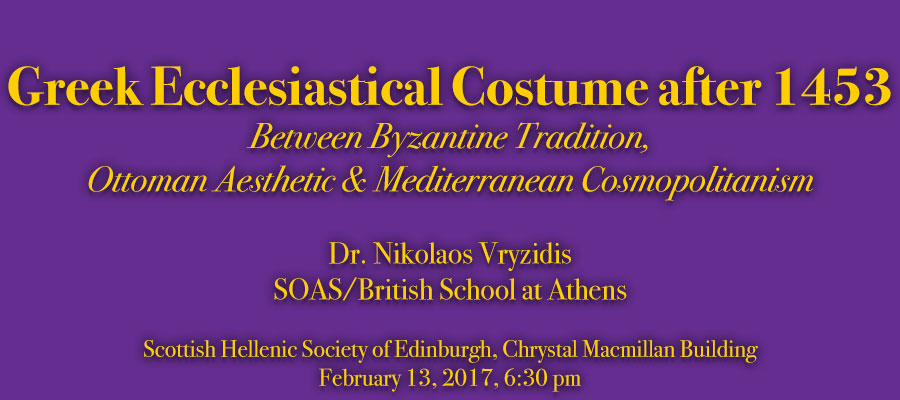Greek Ecclesiastical Costume after 1453: Between Byzantine Tradition, Ottoman Aesthetic, and Mediterranean Cosmopolitanism, lecture by Dr. Nikolaos Vryzidis (SOAS/British School at Athens), Scottish Hellenic Society of Edinburgh, Chrystal Macmillan Building, February 13, 2017, 6:30 pm
The sack of Constantinople in 1453 brought an end to a long period of Byzantine decline and imposed a new political status quo where the Greeks were no longer represented by a state. The Ottoman model of governance assigned bureaucratic duties to the Byzantine Imperial Church apart from its spiritual role, turning it into an institution that represented the Greeks to the Porte. This dualism, I argue, is vividly reflected on the composite dress code adopted by the Greek Church almost immediately after these changes were effected. In the core of this semiotic construction lies the juxtaposition of two fundamentally dissimilar systems of symbolism: the Byzantine and the Ottoman. However, this synergy, and not contradiction, communicated in the most appropriate way the message that the Church desired to deliver: its status as an Ottoman institution which can trace its origin to Byzantium. At the same time the receptivity of Greek ecclesiastical aesthetic allowed the acceptance of all the elements circulating in the Mediterranean at that time, whether Western European or Asian, and their appropriation according to the Orthodox dogma. Essentially, the discussion of all these parallel processes of adoption and adaptation aims at illuminating the Ottoman Greek paradigm and the retention of its cultural autonomy via acculturation.
Nikolaos Vryzidis received his PhD in 2015 from SOAS-University of London after completing a dissertation on Greek ecclesiastical costume of the Ottoman period. He then conducted post-doctoral research based at the British School at Athens and organized an international workshop on Mediterranean textiles. His academic interests include the material culture of Ottoman Christians and artistic exchanges between Byzantium and the Islamic Middle East.
